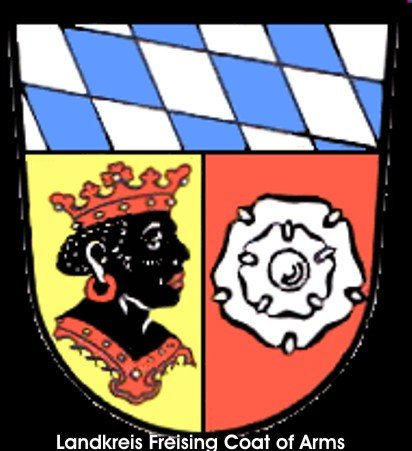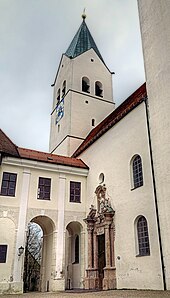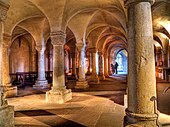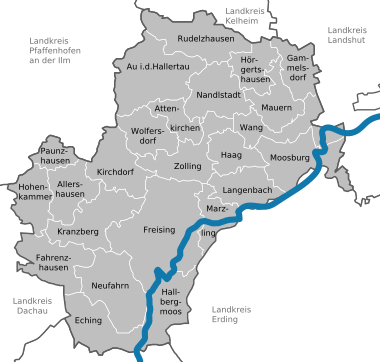Freising district, towns in germany

The Freising district is located in the northeast of the Bavarian administrative region of Upper Bavaria and is part of the Munich region . The proximity to the Bavarian capital Munich as well as the very good transport infrastructure (with the Munich Airport located in the district area and the very good local transport connections to Munich as part of the Munich transport and tariff association ) make the Freising district one of the most sought-after and fastest-growing economic and Residential locations in Germany. In the current economic strength ranking by Focus magazine, it is ranked third among all German districts, after the neighboring districts of Munich and Pfaffenhofen. [2]
Geography
Location
The district area essentially comprises two landscapes: In addition to the Danube-Isar hill country in the north and in the middle of the district, which also takes up the much larger portion of the district's area, there are also foothills of the Munich gravel plain in the extreme south and on the eastern district border Form of the Freisinger and Erdinger moss. The Isar , Amper and Glonn run through the district as first-class water bodies . While the Isar flows from south-west to north-east, its tributary Amper and its tributary Glonn flow in a west-east direction through the district.
Important Places
The largest towns are the large district town of Freising and the municipality of Neufahrn , followed by the city of Moosburg . The oldest town in the district is Moosburg, which received town charter in 1331, before Freising (1359).
Neighboring districts
The district borders clockwise in the north, starting with the districts of Kelheim , Landshut , Erding , Munich , Dachau and Pfaffenhofen an der Ilm .
History
Regional courts
Even before 1803, the district area predominantly belonged to Bavaria and was assigned to the Kranzberg and Moosburg regional courts . Only the Prince-Bishopric of Freising with the city of Freising and the county of Ismaning (with parts also in the Munich district ) was its own spiritual territory, which was secularized in 1802 and incorporated into the Electorate of Bavaria. In 1803, the Moosburg regional court was incorporated into the state's new organization without any changes. At the beginning of 1804, the Kranzberg regional court was dissolved and the regional court in Freising was rebuilt. The two regional courts of Freising and Moosburg had been part of the Isarkreis since 1808 ( Upper Bavaria from 1838 ).
- District judge
- Karl Freiherr von Stromer (from 1804)
- Maximilian von Ockl (from 1805)
- Franz Bernhard Grosch (1817–1849)
- Karl Breidenbach (1849–1862)
District office
In 1862, both regional court districts were administratively united to form the Freising district office . [3] The previous district judge Karl Breidenbach became the first district magistrate. The Freising and Moosburg regional courts continued to exist as judicial authorities until 1879 and were then converted into district courts .
On July 1, 1862, the city of Freising left the district office and became a city within the district .
On January 1, 1905, the municipality of Neustift was incorporated into the city of Freising.
On February 1, 1927, the Freising district office was expanded to include the Pfrombach community of the Erding district office.
County
On January 1, 1939, like everywhere else in the German Reich, the name district was introduced. [4] This is how the district office became the Freising district.
On April 1, 1940, Freising was incorporated into the Freising district, but this was reversed on February 8, 1946. As part of the regional reform in Bavaria, the district was enlarged on July 1, 1972. The city of Freising was reincorporated into the district and was given the status of a large district town in return for the loss of district freedom . Also new to the district were the communities of Au in der Hallertau , Berg , Enzelhausen , Grafendorf , Grünberg , Günzenhausen , Haslach , Osseltshausen , Osterwaal , Rudertshausen and Tegernbach from the dissolved Mainburg district , as well as the Fahrenzhausen community from the Dachau district . [5]
On May 1, 1978, the Goldach district of the Notzing municipality in the Erding district was transferred to Hallbergmoos in the Freising district. At the same time, the district gave the community of Bruckberg to the Landshut district.
Three municipalities in the Freising district have a total of 51% of the area of Munich Airport, which opened on May 11, 1992 : the southwest belongs to the municipality of Hallbergmoos , the northwest with the visitor park belongs to the city of Freising. A very small part on the northern border of around 2.8 hectares belongs to the municipality of Marzling .
Population development
From 1988 to 2008, the Freising district gained over 43,000 residents or grew by around 35%. During the period mentioned, this is the second highest percentage increase in population of a district in Bavaria - after the neighboring district of Erding. Between 1988 and 2018, the district grew by 56,747 inhabitants or by 46.4%, from 122,369 to 179,116.
The following population figures refer to the area as of May 25, 1987:
| Population development | ||||||||||||||
|---|---|---|---|---|---|---|---|---|---|---|---|---|---|---|
| Year | 1840 | 1900 | 1939 | 1950 | 1961 | 1970 | 1987 | 1991 | 1995 | 2000 | 2005 | 2010 | 2015 | 2020 |
| Resident | 32,763 | 48,212 | 59,250 | 82,737 | 81,374 | 95,153 | 118,518 | 132,536 | 141,022 | 152,307 | 160,655 | 166,375 | 173,225 | 180,313 |

Economy, infrastructure, science
In the 2019 Future Atlas, the Freising district ranked 34th out of 401 districts, municipal associations and independent cities in Germany, making it one of the regions with “very high future prospects”. [7]
Business and Science
In the Freising district there are over 73,000 employees subject to social security contributions in well over 4,000 companies. The unemployment rate was 1.9% (1,959 people) in May 2015 and was one of the lowest in Germany. Munich Airport, located on the district border, is an important economic factor. Despite a rapidly growing “high-tech landscape”, the Freising district still has a very good mix of medium-sized businesses. Today, three quarters of our output is provided in trade, transport and services and only one percent in agriculture . In addition, the region is one of the top locations in Germany in the areas of biotechnology and logistics . There is no need to shy away from comparison with other locations in the areas of expertise in nutrition and food science or in information and communication technology. The district is now growing by around 2,000 people every year. With an average age of 38, it has the youngest residents in all of Bavaria.
The Freising district is the headquarters of the Weihenstephan Science Center for Nutrition, Land Use and the Environment at the Technical University of Munich . It is one of the world's most renowned teaching and research centers in the field of the so-called life sciences, as it covers the complete spectrum of life science research, in particular the food chain from plant and animal breeding to agricultural and forestry sciences to nutritional science and medicine. Around 3,500 students are preparing here for their future careers. What is unique about the Weihenstephan Science Center is the close networking of research disciplines. Weihenstephan University has also been located in Weihenstephan since 1971 and offers numerous innovative, green and practical courses of study.
Tourism

main portal ⊙
The Domberg in Freising with the Diocesan Museum and Freising's old town are the main attractions. The Kastulusmüster is located in Moosburg an der Isar .
Three long-distance cycle paths lead through the district: the Isar cycle path through the Isarau forest, the 201 km long Ammer-Amper cycle path through the Ampertal and the international long-distance cycle path Munich - Regensburg - Prague along the Isar and through the Hallertau hop-growing region .
The Hallertau , the largest contiguous hop-growing region in the world, is partly located in the Freising district; The hop sticks shape the image of the Hallertau.

Traffic
The Freising district has very convenient transport connections. It is part of the Munich transport and tariff association and also includes the largest part of Munich Airport , which is served by the airport express from Regensburg and the S-Bahn lines 1 and 8 from Munich through the district.
The Munich – Regensburg main line, opened by the Bavarian Eastern Railway AG in 1858, is also served by S-Bahn line 1 to the district town of Freising. Other stops for regional trains are Marzling, Langenbach and Moosburg , all of which are still part of the MVV tariff area.
While the S 1 stops in Eching and Neufahrn and the S 8 stop in Hallbergmoos have had a transfer-free connection to the airport since 1992 and 1998, after the Neufahrner curve was completed in 2018, a new regional express from the direction of Regensburg also became a transfer-free one Connection of the other stops to the airport realized.
The Munich subway line 6 is also worth mentioning because it ends at the district border, in the immediate vicinity of the Dietersheim district of Eching , in the Garching research area and is therefore also integrated into the regional bus network. Furthermore, the Munich – Treuchtlingen railway line (with Paindorf train station just 500 m away) runs just past the district area.
Two local railway lines of the Bavarian State Railways were built in the Hallertau around the turn of the century : the first was the line from Wolnzach to Mainburg in 1895 and then, branching off in Enzelhausen in 1909, the line via Au and Nandlstadt to Langenbach near Freising. Passenger traffic was stopped on these two routes in 1969, but on the Unterzolling–Langenbach section only in 1973.
The federal highways 9 (Munich-Nuremberg) and 92 (Munich-Deggendorf) as well as the federal highways 11 , 13 and 301 , as well as the state highways 2045, 2053, 2054, 2084, 2085, 2331, 2339, 2341 and 2584 access the district.
-

Train
-
R-Bahn
-

Subway
-

Regional bus
Since the local elections on March 15, 2020, the seats in the Freising district council have been distributed as follows: [8] [9]
Committees
- District committee
- Youth Welfare Committee
- Committee for Planning, Environment, Tourism, District Development and Infrastructure
- Committee for Schools, Culture and Sport
- Committee on Demographic and Social Questions
- Audit Committee
Other committees
- Supervisory Board of Hospital Freising GmbH
- Erding Rescue Association
- Supervisory Board Wohnungsbau GmbH in the Freising district
- Association meeting Sparkasse Freising Moosburg
District magistrates until 1938, district administrators from 1939
- 1913–1923: Rudolf Gschwendner
- 1924–1934: Karl Schels
- 1934–1945: Heinrich Heidenreich ( NSDAP )
- 1945–1966: Philipp Held ( CSU )
- 1966–1996: Ludwig Stepnoloher (CSU)
- 1996–2008: Manfred Pointner (PFW)
- 2008–2014: Michael Schwaiger (FW)
- 2014–2020: Josef Hauner (CSU)
- since May 1, 2020: Helmut Petz (FW) [10]
Coat of arms
County Facilities
Clinic
- Klinikum Freising , academic teaching hospital of the Technical University of Munich , operated by Klinikum Freising GmbH
Schools (run by the district)
- Freising Special Education Center (special education school with a focus on learning, language and social-emotional development)
- Camerloher High School , Freising
- Dom-Gymnasium, Freising
- Karl-Ritter-von-Frisch-Gymnasium , Moosburg
- Oskar-Maria-Graf-Gymnasium, Neufahrn (in association with the municipality of Neufahrn )
- Business school, Freising
- Technical/vocational high school, Freising
- State vocational school center, Freising
- Imma Mack Secondary School, Eching
- Kastulus secondary school, Moosburg
- Karl Meichelbeck secondary school
- Gute Änger secondary school, Freising
- Au secondary school in Hallertau
Communities
The largest municipality in the district is the large district town of Freising with 45,118 inhabitants (with secondary residences 48,462), followed by the municipality of Neufahrn bei Freising with 18,973 (21,156) inhabitants and the city of Moosburg an der Isar with 17,487 inhabitants.
(Residents as of December 31, 2022 [12] )

| City | coat of arms | Area km² |
Residents December 31, 2019 |
EW density EW per km² |
Height above sea level |
|---|---|---|---|---|---|
| Freising , large district town | 88.60 | 49,339 | 557 | 448 | |
| Moosburg ad Isar | 43.85 | 19,832 | 452 | 421 |
| market | coat of arms | Area km² |
Residents December 31, 2019 |
EW density EW per km² |
Height above sea level |
|---|---|---|---|---|---|
| Au idHallertau | 54.98 | 6,304 | 115 | 452 | |
| Nandlstadt | 34.30 | 5,587 | 163 | 465 |
| Community | coat of arms | Area km² |
Residents December 31, 2019 |
EW density EW per km² |
Height above sea level |
|---|---|---|---|---|---|
| Allershausen | 26.55 | 6,104 | 230 | 442 | |
| Attenkirchen | 16.11 | 2,768 | 172 | 524 | |
| Eching | 37.31 | 14,130 | 387 | 469 | |
| Fahrenzhausen | 37.64 | 5,150 | 137 | 465 | |
| Gammelsdorf | 21.63 | 1,519 | 70 | 495 | |
| Hague adAmper | 21.71 | 3,009 | 139 | 440 | |
| Hallberg moss | 35.07 | 11,337 | 333 | 460 | |
| Hohenkammer | 25.74 | 2,713 | 105 | 471 | |
| Hörgertshausen | 21.48 | 2,016 | 94 | 453 | |
| Kirchdorf adAmper | 32.96 | 3,270 | 99 | 440 | |
| Kranzberg | 39.51 | 4,226 | 107 | 483 | |
| Langenbach | 26.89 | 4,105 | 153 | 429 | |
| Marzling | 20.50 | 3,306 | 161 | 443 | |
| walls | 24.14 | 3,144 | 130 | 435 | |
| Neufahrn b.Freising | 45.53 | 20,202 | 452 | 464 | |
| Paunzhausen | 12.72 | 1,604 | 126 | 509 | |
| Rudelzhausen | 40.81 | 3,517 | 86 | 440 | |
| Wang | 31.19 | 2,612 | 84 | 415 | |
| Wolfersdorf | 26.05 | 2,575 | 99 | 502 | |
| Zolling | 34.54 | 5,051 | 146 | 429 |
Administrative communities
- Allershausen with the member communities of Allershausen and Paunzhausen
- Mauern with the member communities Gammelsdorf, Hörgertshausen, Mauern and Wang
- Zolling with the member communities Attenkirchen, Haag adAmper, Wolfersdorf and Zolling
Municipalities before the regional reform in 1971/78
Before the regional reform, the Freising district had 69 municipalities (see list below). The municipality of Neustift became part of the city of Freising in 1905, Vötting in 1937. The municipality of Hagsdorf was incorporated into Pignersdorf in 1935 and the municipality of Johanneck was incorporated into Paunzhausen on April 1, 1939 .
In the north the district bordered on the Mainburg district , in the northeast on the Landshut district , in the southeast on the Erding district , in the south on the Munich district , in the southwest on the Dachau district and in the northwest on the Pfaffenhofen adIlm district . The city of Freising was not part of the district, but an independent city, but was still the seat of the district administration.
The municipalities of the Freising district before the municipal reform in 1971/78. [13] [14] (Churches that still exist today are written in bold .)
| Former community | Today's community | Today's district |
|---|---|---|
| Abens (formed in 1971 from the communities of Hemhausen and Hirnkirchen ; incorporated into Au idHallertau in 1978) |
Au idHallertau | Freising district |
| Airischwand | Nandlstadt | Freising district |
| Aiterbach | Allershausen | Freising district |
| Allershausen | Allershausen | Freising district |
| Anglberg | Zolling | Freising district |
| Appersdorf | Zolling | Freising district |
| attaching | Freising | Freising district |
| Attenkirchen | Attenkirchen | Freising district |
| Baumgarten | Nandlstadt | Freising district |
| Berghaselbach | Wolfersdorf | Freising district |
| Bruckberg | Bruckberg | Landshut district |
| Bruckbergerau | Bruckberg | Landshut district |
| Dürnhaindlfing | Wolfersdorf | Freising district |
| Eching | Eching | Freising district |
| Enghausen | walls | Freising district |
| Figlsdorf | Nandlstadt | Freising district |
| Gammelsdorf | Gammelsdorf | Freising district |
| Giggenhausen | Neufahrn b.Freising | Freising district |
| Gremertshausen | Kranzberg | Freising district |
| Großnöbach | Fahrenzhausen | Freising district |
| Gunzenhausen | Eching | Freising district |
| Hague adAmper | Hague adAmper | Freising district |
| Haindlfing | Freising | Freising district |
| Hallberg moss | Hallberg moss | Freising district |
| Hemhausen | Au idHallertau | Freising district |
| Hirnkirchen | Au idHallertau | Freising district |
| Hohenbercha | Kranzberg | Freising district |
| Hohenkammer | Hohenkammer | Freising district |
| Hörgertshausen | Hörgertshausen | Freising district |
| Inkofen | Hague adAmper | Freising district |
| Inzkofen | Wang | Freising district |
| Itzling | Freising | Freising district |
| Jarzt | Fahrenzhausen | Freising district |
| Kammerberg | Fahrenzhausen | Freising district |
| Kirchdorf adAmper | Kirchdorf adAmper | Freising district |
| Kranzberg | Kranzberg | Freising district |
| Langenbach | Langenbach | Freising district |
| Lauterbach | Fahrenzhausen | Freising district |
| Margarethenried | Hörgertshausen | Freising district |
| Marzling | Marzling | Freising district |
| Massenhausen | Neufahrn b.Freising | Freising district |
| walls | walls | Freising district |
| Moosburg ad Isar | Moosburg ad Isar | Freising district |
| Nandlstadt | Nandlstadt | Freising district |
| Neufahrn b.Freising | Neufahrn b.Freising | Freising district |
| Niederambach | Moosburg ad Isar | Freising district |
| Oberhummel | Langenbach | Freising district |
| Palzing | Zolling | Freising district |
| Paunzhausen | Paunzhausen | Freising district |
| Pfettrach | Attenkirchen | Freising district |
| Pfrombach | Moosburg ad Isar | Freising district |
| Plörnbach | Hague adAmper | Freising district |
| Pulling | Freising | Freising district |
| Reichersdorf | Gammelsdorf | Freising district |
| Reichertshausen | Au idHallertau | Freising district |
| Rudlfing | Marzling | Freising district |
| Ties | Hohenkammer | Freising district |
| Pignersdorf | Wang | Freising district |
| Sillertshausen | Au idHallertau | Freising district |
| Sünzhausen | Freising | Freising district |
| Thalhausen | Kranzberg | Freising district |
| Thonstetten | Moosburg ad Isar | Freising district |
| Tüntenhausen | Freising | Freising district |
| Tünzhausen | Allershausen | Freising district |
| Volkmannsdorferau | Wang | Freising district |
| Wang | Wang | Freising district |
| Wimpasing | Attenkirchen | Freising district |
| Wippenhausen | Kirchdorf adAmper | Freising district |
| Wolfersdorf | Wolfersdorf | Freising district |
| Zolling | Zolling | Freising district |
What's Your Reaction?





















